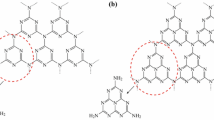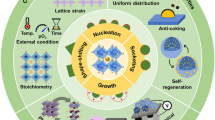Abstract
More catalytic active sites and fast interfacial charge transfer rates have been shown to be effective strategies to enhance photocatalytic water decomposition. In this work, a microconical textured silicon wafer was constructed by wet chemical etching. Fe3O4 nanospheres and NixSy (NiS and Ni3S4 complexes) nanoclusters were prepared by solvothermal method, and Fe3O4 and NixSy were deposited on Si micropyramids (denoted as Fe3O4/NiS/Ni3S4@SiMPs) by drop-coating methods. Fe3O4/NiS/Ni3S4@SiMPs exhibited excellent photoelectrochemical properties and good stability at the composite ratio of Fe3O4 to NixSy was 1:5, and the starting potential of the composite was 0.29 V vs.RHE, maximum photohydrogen conversion efficiency was 0.32% (+ 1.21 V vs. RHE), photocurrent density was 0.82 mA cm−2. Fe3O4/NiS/Ni3S4@SiMPs exhibited 42 times higher photocurrent density than NixSy@SiMPs with long-term stability was up to 4 h. The results show that Fe3O4 significantly improved the photoelectrochemical performance of NixSy@SiMPs composites, mainly because that Fe3O4 nanospheres have high conductivity contributing to photogenerated carrier migration, and the heterojunction between semiconductors with different energy levels (Fe3O4, NixSy, Si) effectively inhibited the recombination of electrons and holes. This work provides directions for the preparation and photoelectrochemical properties of monocrystalline silicon-based supported NixSy and Fe3O4 composites.








Similar content being viewed by others
Data availability
The data that support the findings of this study are available on request from the corresponding author, [Li Zhang], upon reasonable request.
References
J.J. West, S.J. Smith, R.A. Silva, V. Naik, Y. Zhang, Z. Adelman, M.M. Fry, S. Anenberg, L.W. Horowitz, J.-F. Lamarque, Nat. Clim. Change 3, 885–889 (2013)
R. van de Krol, Y. Liang, J. Schoonman, J. Mater. Chem. 18, 2311–2320 (2008)
G. Paulraj, P.S. Venkatesh, P. Dharmaraj, S. Gopalakrishnan, K. Jeganathan, Int. J. Hydrogen Energy 45, 1793–1801 (2020)
S. Guan, X. Fu, Y. Zhang, Z. Peng, Chem. Sci. 9, 1574–1585 (2018)
C. Xue, H. Li, H. An, B. Yang, J. Wei, G. Yang, Acs Catal. 8, 1532–1545 (2018)
X. Shi, S. Kim, M. Fujitsuka, T. Majima, Appl. Catal. B-Environ. 254, 594–600 (2019)
P. Pramanik, S. Biswas, J. Solid State Chem. 65, 145–147 (1986)
L. Wei, Y. Chen, J. Zhao, Z. Li, Beilstein J. Nanotech. 4, 949–955 (2013)
A. Ubale, A. Bargal, Mater. Res. Bull. 46, 1000–1010 (2011)
J. Zhang, S.Z. Qiao, L. Qi, J. Yu, Phys. Chem. Chem. Phys. 15, 12088–12094 (2013)
X. Zhao, J. Bao, Y. Zhou, Y. Zhang, X. Sheng, B. Wu, Y. Wang, C. Zuo, X. Bu, New J. Chem. 46, 5505–5514 (2022)
Y. Wang, J. Zhao, W. Hou, Y. Xu, Appl. Catal. B-Environ. 310, 121350 (2022)
J. Chang, S. Zang, Y. Wang, C. Chen, D. Wu, F. Xu, K. Jiang, Z. Bai, Z. Gao, Electrochim. Acta 353, 136501 (2020)
Z. Yang, B. Cui, Y. Bu, Y. Wang, J. Alloy. Compd. 775, 826–835 (2019)
L. Zhang, W. Chen, L. Cheng, L. Jiang, X. Deng, J. Yan, H. Yang, J. Mater. Sci. 32, 5176–5185 (2021)
X. Christodoulou, S.B. Velasquez-Orta, Environ. Sci. Technol. 50, 11234–11242 (2016)
X. Wang, D. Jiang, C. Jing, X. Liu, K. Li, M. Yu, S. Qi, Y. Zhang, J. Energy Storage. 30, 101554 (2020)
G. Liu, B. Wang, P. Ding, Y. Ye, W. Wei, W. Zhu, L. Xu, J. Xia, H. Li, J. Alloy. Compd. 797, 849–858 (2019)
M. Mollavali, C. Falamaki, S. Rohani, Int. J. Hydrogen Energy 40, 12239–12252 (2015)
H. Chen, J. Jiang, L. Zhang, H. Wan, T. Qi, D. Xia, Nanoscale 5, 8879–8883 (2013)
L. Peng, X. Ji, H. Wan, Y. Ruan, K. Xu, C. Chen, L. Miao, J. Jiang, Electrochim. Acta 182, 361–367 (2015)
Q. Pan, J. Xie, T. Zhu, G. Cao, X. Zhao, S. Zhang, Inorg. Chem. 53, 3511–3518 (2014)
M.-L. Guo, S.-P. Wan, C.-L. Li, K. Zhang, Rare Met. 41, 3795–3802 (2022)
L. Acharya, S. Nayak, S.P. Pattnaik, R. Acharya, K. Parida, J. Colloid Interface Sci. 566, 211–223 (2020)
Z. Zhang, R. Dua, L. Zhang, H. Zhu, H. Zhang, P. Wang, ACS Nano 7, 1709–1717 (2013)
H. Sun, W. Hua, S. Liang, Y. Li, J.-G. Wang, J. Mater. Chem. A 10, 20414–20423 (2022)
T.W. Hamann, N.S. Lewis, J. Phys. Chem. B 110, 22291–22294 (2006)
H. Sun, W. Hua, S. Liang, Y. Li, J.-G. Wang, J. Colloid Interface Sci. 611, 278–286 (2022)
Acknowledgements
This study was financially supported by the Open Fund Project of Key Laboratory of Fine Petrochemical Catalysis and Separation of Hunan Province of China (No. HNPCCS201901).
Funding
This work was funded by Hunan Provincial Science and Technology Department (Grant No. 414006).
Author information
Authors and Affiliations
Contributions
All authors contributed to the study concept and design. Material preparation, data collection and analysis were carried out by ZZ, WC and XC. The first draft of the manuscript was written by ZZ and all authors commented on previous versions of the manuscript. All authors read and approved the final manuscript.
Corresponding author
Ethics declarations
Conflict of interest
The authors have not disclosed any competing interests.
Additional information
Publisher's Note
Springer Nature remains neutral with regard to jurisdictional claims in published maps and institutional affiliations.
Rights and permissions
Springer Nature or its licensor (e.g. a society or other partner) holds exclusive rights to this article under a publishing agreement with the author(s) or other rightsholder(s); author self-archiving of the accepted manuscript version of this article is solely governed by the terms of such publishing agreement and applicable law.
About this article
Cite this article
Zhong, Z., Chen, W., Chen, X. et al. Nano-spherical Fe3O4 modified NixSy@SiMPs composite materials improve photoelectrochemical performance. J Mater Sci: Mater Electron 35, 244 (2024). https://doi.org/10.1007/s10854-024-12020-w
Received:
Accepted:
Published:
DOI: https://doi.org/10.1007/s10854-024-12020-w




